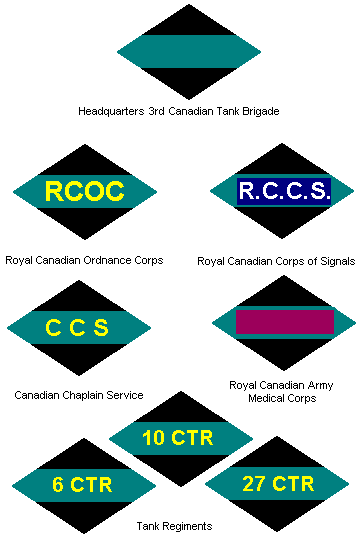3rd Canadian Tank Brigade
|
3rd Canadian
Tank Brigade
|
 |
Authorized:
Created from 3rd Armoured Brigade 1 January
1943 (General Order 223/43)
Disbanded: 1943 |
|
The 3rd Canadian Army
Tank Brigade was an ad hoc unit formed from three surplus
armoured regiments when armoured division establishments were changed in
January 1943 from two brigades of armour to just one. The 6th Canadian
Armoured Regiment (1st Hussars), 10th Canadian Armoured Regiment (The
Fort Garry Horse), (both previously of the 5th Canadian (Armoured)
Division) and 27th Canadian Armoured Regiment (The Sherbrooke Fusilier
Regiment) (previously of 4th Canadian (Armoured) Division). The
headquarters of the 3rd Canadian Armoured Brigade was redesignated 3rd
Canadian Army Tank Brigade by General Order 223/1943 on 1 January 1943,
with the 3rd and 4th Armoured Brigade headquarters disbanding officially
on the same date by General Order 225/1943.
In July 1943 both the 2nd and 3rd Army Tank Brigades were inspected to
select just one of them to remain on the order of battle, as a change in
the order of battle of armoured divisions meant that only one armoured
brigade would be required. Lieutenant General Harry Crerar, General
Officer Commanding I Canadian Corps, selected the 2nd Brigade and units
of the 3rd Brigade were reassigned to become the 2nd Canadian Armoured
Brigade.
Uniform Insignia
 At
the start of the Second World War, it was felt that colourful unit and
formation insignia would be too easily seen, and a very austere set of
insignia was designed for the new Battle Dress uniform, consisting
solely of rank badges and drab worsted Slip-on Shoulder Titles. In 1941,
however, the trend was reversed, and a new system of formation patches,
based on the battle patches of the First World War, was introduced.
However, the use of lettered unit titles (at first won as Slip-on
Shoulder Titles and later, as more colourful designs worn directly above
the divisional patches) was also introduced - a privilege previously
extended only to the Brigade of Guards in England, and in the Canadian
Army to just four units: Governor General's Foot Guards, Canadian
Grenadier Guards, Princess Patricia's Canadian Light Infantry and the
Canadian Provost Corps. At
the start of the Second World War, it was felt that colourful unit and
formation insignia would be too easily seen, and a very austere set of
insignia was designed for the new Battle Dress uniform, consisting
solely of rank badges and drab worsted Slip-on Shoulder Titles. In 1941,
however, the trend was reversed, and a new system of formation patches,
based on the battle patches of the First World War, was introduced.
However, the use of lettered unit titles (at first won as Slip-on
Shoulder Titles and later, as more colourful designs worn directly above
the divisional patches) was also introduced - a privilege previously
extended only to the Brigade of Guards in England, and in the Canadian
Army to just four units: Governor General's Foot Guards, Canadian
Grenadier Guards, Princess Patricia's Canadian Light Infantry and the
Canadian Provost Corps.
The new formation patches were made from three materials mainly; felt
and wool being most common, and canvas patches were adopted in the late
war period as an economy measure.
Members of various corps serving in support units came to wear formation
patches with letters added directly to the patch. A formation patch with
a maroon coloured strip in the middle was worn by some members of the
Royal Canadian Army Medical Corps (RCAMC).
The Formation Patch of the 3rd Canadian Army Tank Brigade was a black
diamond bisected by a French-grey stripe.
|
Image and artifacts
at right courtesy Mark Giroux, Ontario Regiment Museum. Photos and
artifacts below courtesy Bill Alexander.
|
 |
|